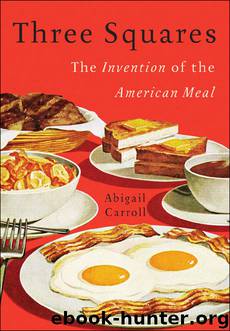Three Squares by Abigail Carroll

Author:Abigail Carroll [Carroll, Abigail]
Language: eng
Format: epub
ISBN: 9780465040964
Publisher: Basic Books
7
SNACKING REDEEMED
IN HORATIO ALGER’S 1868 novel Ragged Dick, the protagonist, a twice-orphaned street boy, is all “rags and dirt.” He sleeps in a straw-filled cardboard box, dons hole-riddled trousers, and bears grimy streaks across his face. His appearance says much about his lot in life, but equally telling is the food he subsists on: dry bread and apples. When he has a few pennies, he goes to the Old Bowery, a theater frequented by immigrants, and eats peanuts in one of the cheap galleries. One step above living on peanuts and apples is selling them, and Dick dreams of trading his boot blacking for a more “genteel” occupation, such as keeping an apple stand or “disseminatin’ peanuts among the people.” But even Dick knows that such a business is hardly more genteel. He recounts to a friend the sad decline of a beautiful young lady who, having lost her husband to a Broadway carriage accident, has been forced to open an apple and peanut stand. “There she is now”—Dick points her out—“a hideous old woman.”1
Details such as these in Horatio Alger’s novel provide today’s readers a glimpse of nineteenth-century public perceptions, including prevalent attitudes toward snacks. Although peddlers and vendors furnished the opportunity to procure snacks (or, as in Dick’s case, meals) and selling snacks opened up avenues for the impoverished to make a few pennies, such foods bore a certain stigma. They were inextricably linked with the street and those forced to live on it and make it their business. Two additional factors compounded this stigma. First, many of the poor who sold street food were foreigners. Their accents and unusual garb announced a deep cultural difference that prevented many Americans from trusting these foods. Second, when it came to hawking their wares off the streets, vendors favored rowdy, working-class places of entertainment—fairs, sports games, vaudeville theaters—and these lowbrow sites left their imprint on American perceptions of the kinds of food associated with eating between meals.
Although marred by its associations with unclean, impoverished, foreign vendors and rowdy, working-class entertainment, snack food—food products designed and sold primarily for between-meal consumption—was eventually redeemed, and the story of its salvation hinges on commercialization. When entrepreneurs began manufacturing snack food on a larger, more industrial scale, they cleaned up snacking’s image, and their key tactic was developing enticing boxes, cartons, and bags. Sealing products in packages, a strategy breakfast cereal makers also came to rely on, removed the huckster and the dusty cracker barrel from the once iffy munching equation, while, at the same time, opening up a world of possibilities for advertising. Packaging also escorted snacks into a new realm: the home. No longer were munchies merely extensions of ballparks, circuses, sidewalk carts, and, later, cinemas; nor was their consumption limited to special occasions such as outings and holidays. Now people could buy them at the grocery store, stash them in the cupboard, and enjoy them at leisure on the patio or in the living room at any time of day, on any day of the year.
Download
This site does not store any files on its server. We only index and link to content provided by other sites. Please contact the content providers to delete copyright contents if any and email us, we'll remove relevant links or contents immediately.
| Africa | Americas |
| Arctic & Antarctica | Asia |
| Australia & Oceania | Europe |
| Middle East | Russia |
| United States | World |
| Ancient Civilizations | Military |
| Historical Study & Educational Resources |
Cat's cradle by Kurt Vonnegut(14784)
Pimp by Iceberg Slim(13806)
Underground: A Human History of the Worlds Beneath Our Feet by Will Hunt(11848)
4 3 2 1: A Novel by Paul Auster(11819)
The Radium Girls by Kate Moore(11639)
Wiseguy by Nicholas Pileggi(5333)
American History Stories, Volume III (Yesterday's Classics) by Pratt Mara L(5141)
Perfect Rhythm by Jae(5080)
The Fire Next Time by James Baldwin(5033)
Paper Towns by Green John(4811)
Pale Blue Dot by Carl Sagan(4631)
A Higher Loyalty: Truth, Lies, and Leadership by James Comey(4565)
The Mayflower and the Pilgrims' New World by Nathaniel Philbrick(4287)
The Doomsday Machine by Daniel Ellsberg(4253)
Killers of the Flower Moon: The Osage Murders and the Birth of the FBI by David Grann(4195)
Too Much and Not the Mood by Durga Chew-Bose(4104)
The Sympathizer by Viet Thanh Nguyen(4099)
The Borden Murders by Sarah Miller(4032)
Sticky Fingers by Joe Hagan(3916)
